Data is the oxygen that the circular economy thrives on: part 1. This article is an initiative of Amsterdam University of Applied Sciences | City of Amsterdam | Amsterdam Economic Board | Amsterdam Smart City | Metabolic | AMS Institute. Together we are working to accelerate the circular economy in the Amsterdam Metropolitan Area, sharing practical stories for and about entrepreneurs and businesses. As a Communication Alliance for a Circular Region (CACR).
We are on the way to the circular economy becoming the new normal. Numerous organisations in the Amsterdam Metropolitan Area are already hard at work on circular initiatives. However, we can only take significant strides and make these initiatives profitable if we are smarter with data. In the first part of this series we will explain what the circular economy really is and the opportunities that it affords us. Scroll down for Dutch!
Less waste, fewer raw materials and a reduction in CO2 emissions
The circular economy is a new economy. As part of it, we consume and produce responsibly, respecting the limits of our planet and keeping an eye on justice and social values. In a circular economy we do not produce waste, but rather re-use existing raw materials on a massive scale and to the highest possible quality. In doing so, we use fewer new raw materials and the value of products, resources and raw materials is preserved within our economic system for as long as possible.
In a circular economy we have moved away from the destructive ‘take-make-waste’ system. We protect the scarce raw materials that we depend upon, for example, for technology and the energy transition. And crucially, in doing so, we help to reduce global CO2 emissions. After all, more than half of global CO2 emissions are now the indirect result of our consumption habits and the associated production of resources and goods. On top of that, our traditional consumption habits have contributed to the exploitation of workers in far-off countries – be it in mining operations or the clothing industry. Another important consideration is that the circular economy can actually boost employment within the region, as more jobs will be created in the repair and processing sector.
Availability of materials
Contributing to the success of a circular economy is not only a socially responsible action and good for your reputation: your entire company can benefit from it. A key example is in securing the availability of resources in the long term and integrating this new, circular way of working into your new or existing business model. By operating in a circular way, your company becomes more future-proof.
For example, by reusing raw materials and products, you are less dependent on complex international logistics chains – a factor that has been of particular relevance during the coronavirus crisis. As a result of the crisis, a large number of production facilities around the world were forced to close, causing international trade to move – temporarily or otherwise – to local markets.
Another important reason to operate with circular principles is that customers – governments, businesses and consumers – will place increasingly higher demands on your company. For example, the City of Amsterdam’s goal is that 10% of its procurement must be circular by the end of 2022, and that all procurement conditions and contracts in the built environment should be circular by the end of 2023. The City is also working on a monitoring platform that uses many types of data to measure the extent to which Amsterdam is already circular, highlighting the areas in which things are going well or need to improve. More and more organisations are also signing up with Inkopen met Impact (‘Procurement with Impact’), an initiative launched by the Amsterdam Economic Board that stimulates circular and sustainable procurement and in which data also plays an important role. The market for circular products is going from strength to strength in the Amsterdam Metropolitan Area: if you are already active in that market, you will find it easier to establish a strong foothold.
Circular chains and circular examples
Larger companies that have already made part of their chains circular have certainly found that they have a strong business case on their hands. Excellent examples include Auping, which gives used mattresses a second life, and Signify, which offers Circular Lighting as a service. In fact, more and more companies are following suit by also offering their products as a service. It is an ideal business model for the circular economy, as customers pay for the use of a product rather than the ownership of it. As a supplier of this service, you are incentivised to produce a sustainable product, parts of which are easily replaceable.
Additionally, there are already many successful companies selling products that consist entirely of recycled materials – consider bags that are upcycled from old fire hoses, or advertising banners or plant pots made from recycled plastic.
Data is essential to the success of the circular economy
Tempering these successes, in 2019 the Netherlands Environmental Assessment Agency noted that it is difficult for new circular initiatives to break through. Indeed, there is still room for improvement. What can help? We believe data is the key. Armed with data, we can monitor the effect of adjustments and connect supply and demand in the circular economy. It is for good reason that data is regarded as the circular economy’s oxygen. In the next article we will explore three reasons for approaching this in a smarter way. Then we will show you what you can do yourself, and share the experiences of other circular businesses.
This article is an initiative of Amsterdam University of Applied Sciences | City of Amsterdam | Amsterdam Economic Board | Amsterdam Smart City | Metabolic | AMS Institute. Together we are working to accelerate the circular economy in the Amsterdam Metropolitan Area, sharing practical stories for and about entrepreneurs and businesses. We invite everybody to join the discussion on amsterdamsmartcity.com.
Dutch Version
Volop kansen in de nieuwe circulaire werkelijkheid
Data zijn de zuurstof van de circulaire economie: deel 1
De circulaire economie wordt het nieuwe normaal. In de Metropool Amsterdam werken tal van organisaties al hard aan circulaire initiatieven. Maar pas als we slimmer omgaan met data, kunnen we écht grote stappen zetten en deze initiatieven winstgevend maken. In deze eerste aflevering van een serie leggen we uit wat de circulaire economie eigenlijk is en welke kansen die met zich meebrengt.

Minder afval, minder grondstoffen, minder CO2
De circulaire economie is een nieuwe economie, waarin we op een verantwoorde wijze consumeren en produceren, met respect voor de grenzen die de aarde ons stelt en oog voor rechtvaardigheid en sociale waarden. In een circulaire economie produceren we geen afval en hergebruiken we op grote schaal bestaande grondstoffen op een hoogwaardige manier. Daardoor gebruiken we minder nieuwe grondstoffen en blijft de waarde van producten, materialen en grondstoffen zo lang mogelijk behouden voor ons economisch systeem.
In een circulaire economie hebben we afscheid genomen van het destructieve take-make-waste-principe. We beschermen schaarse grondstoffen die we bijvoorbeeld nodig hebben voor technologie en de energietransitie. En, ook niet onbelangrijk, we helpen de wereldwijde CO2-uitstoot te verminderen. Nu is namelijk meer dan de helft van de wereldwijde CO2-uitstoot indirect het gevolg van ons consumptiegedrag en de daarbij behorende productie van materialen en goederen. Daarnaast draagt ons huidige consumptiegedrag bij aan de uitbuiting van arbeiders in verre landen, zoals in de mijnbouw of de kledingindustrie. Tegelijkertijd kan de circulaire economie juist zorgen voor een nieuwe impuls van de werkgelegenheid in de regio, doordat er meer banen nodig zijn binnen de reparatie- en verwerkingssector.
Beschikbaarheid materialen
Werken aan een circulaire economie is niet alleen maatschappelijk verantwoord en fijn voor je reputatie: je hele bedrijf profiteert ervan. Je verzekert jezelf namelijk van de beschikbaarheid van materialen op de lange termijn en integreert die nieuwe, circulaire werkwijze in je bestaande of nieuwe businessmodel. Je bedrijf is dus toekomstbestendiger als je circulair gaat opereren.
Bijvoorbeeld omdat je door grondstoffen en producten her te gebruiken, minder afhankelijk wordt van complexe internationale logistieke ketens — wat door de huidige coronacrisis extra interessant is. Als gevolg hiervan lagen er wereldwijd immers flink wat productiefaciliteiten noodgedwongen stil en verplaatst de internationale handel zich (al dan niet tijdelijk) naar lokale afnemers.
Een andere belangrijke reden om circulair te gaan opereren is dat klanten, klanten — overheden, bedrijven én consumenten — steeds hogere eisen aan je stellen. Zo wil de gemeente Amsterdam dat in 2022 tien procent van de inkoop circulair is en dat in 2023 alle inkoopvoorwaarden en -contracten in de gebouwde omgeving circulair zijn. Ook werkt de gemeente aan een monitor die allerlei data gebruikt om te meten in hoeverre Amsterdam al circulair is en op welke vlakken het wel of juist niet goed gaat. Daarnaast sluiten steeds meer organisaties zich aan bij Inkopen met Impact, een initiatief van de Amsterdam Economic Board dat circulair en duurzaam inkopen stimuleert, ook daarbij speelt data een belangrijke rol. Binnen de Metropool Amsterdam groeit de markt voor circulaire producten dus rap: als je nu al actief bent op die markt is het makkelijker om daar een stevige positie te verwerven.
Circulaire ketens en circulaire voorbeelden
Grote bedrijven die een deel van hun ketens circulair hebben gemaakt hebben al een goede business case in handen. Neem Auping, dat matrassen een tweede leven geeft, en Signify, dat met Circular Lighting verlichting als dienst aanbiedt. Ook steeds meer andere bedrijven bieden hun producten ‘as-a-service’ aan. Het is een ideaal business model voor de circulaire economie. Klanten betalen dan voor het gebruik van het product, in plaats van voor het bezit ervan. Als leverancier van deze dienst heb je dus een extra prikkel om een duurzaam product te maken, waarvan onderdelen goed vervangbaar zijn.
Daarnaast zijn er al flink wat succesvolle bedrijven die producten verkopen die volledig uit hergebruikte materialen bestaan. Denk aan tassen gemaakt van oude brandweerslangen of reclamedoeken of plantenbakken van gerecycled plastic.
Data belangrijk voor succes circulaire economie
Het Planbureau voor de Leefomgeving stelde vorig jaar echter vast dat nieuwe circulaire initiatieven maar moeilijk doorbreken. Het kan dus nog beter. Hoe? Met data. Met data kunnen we het effect van aanpassingen monitoren en vraag en aanbod in de circulaire economie aan elkaar verbinden. Niet voor niets worden data ook wel de zuurstof van de circulaire economie genoemd. In het volgende artikel geven we je drie redenen om hier slimmer mee om te gaan. Daarna laten we zien wat je zelf kunt doen en delen we de ervaringen van circulaire ondernemers.
Deze artikelenreeks is een initiatief van Hogeschool van Amsterdam | Gemeente Amsterdam | Amsterdam Economic Board | Amsterdam Smart City | Metabolic en AMS Institute. Samen willen zij de circulaire economie in de Metropoolregio Amsterdam versnellen met praktische verhalen voor en over ondernemers en bedrijven. We nodigen iedereen uit mee te doen met de discussie op amsterdamsmartcity.com



